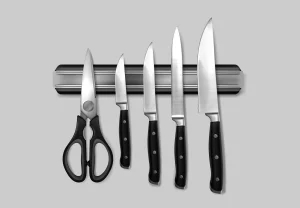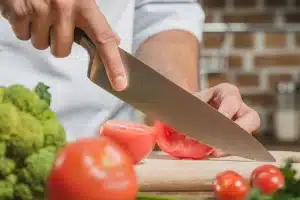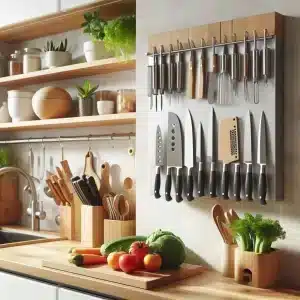Choosing the right utensils affects not just how you cook, but also your health and wallet. In this article, we’ll compare wood and silicone utensils to help you understand which is better for your kitchen. Ready to gear up with the culinary knowledge you need? Let’s dive in!
Understanding the Materials
Wood Utensils
Wooden utensils have been kitchen companions for centuries, known for their durability and natural beauty. Typically made from woods like bamboo, olive, or maple, these utensils are favorites for their robustness and minimal impact on your pots and pans.
Pros and Cons
Advantages of Wood Utensils
- Eco-friendly: Made from a renewable resource, they are biodegradable.
- Safe for cookware: They do not scratch cooking surfaces.
- Durable: With proper care, they can last for years.
Disadvantages of Wood Utensils
- Maintenance: Require more care, are not dishwasher safe, and need to be oiled regularly.
- Hygiene: Can harbor bacteria if not cleaned properly.
Silicone Utensils
On the other hand, silicone utensils are a more modern invention. They are prized for their versatility and safety as they do not react with food or release harmful substances. Plus, silicone can withstand high temperatures without melting, perfect for use on non-stick surfaces.
Advantages of Silicone Utensils
- Easy to clean: Often dishwasher safe.
- Heat resistant: Ideal for handling hot food without the risk of melting.
- Antibacterial: Do not harbor bacteria, making them more hygienic.
Disadvantages of Silicone Utensils
- Durability: Can degrade over time, especially at very high temperatures.
- Cost: Generally more expensive than wood.
Usage Recommendations
For most cooking tasks, we recommend using wooden utensils for their durability and lower environmental impact. However, for high-temperature cooking or when easy cleanup is required, silicone utensils are superior.
Direct Comparison
Here’s a quick comparison chart to summarize the features of each material, explaining why each wins in specific areas:
- Heat Resistance: Silicone wins. Silicone utensils are made to withstand high temperatures, often up to 500°F (260°C) without melting or warping. This makes them ideal for use in high-heat situations like sautéing and baking. Wood, however, can degrade or warp with high heat, and is not suitable for such environments.
- Eco-friendliness: Wood wins. Wooden utensils are crafted from natural, renewable resources such as bamboo or hardwood. They are biodegradable and generally have a lower environmental impact throughout their lifecycle compared to silicone, which is a synthetic material and not biodegradable. Wooden utensils can often be composted at the end of their life, reducing landfill waste.
- Ease of Cleaning: Silicone wins. Silicone is non-porous and resistant to staining and odor absorption, making it easier to clean. These utensils can often be thrown into the dishwasher for a hassle-free clean. Wood utensils, in contrast, require more careful cleaning. They should not be soaked in water and are not dishwasher safe, as water can cause the wood to swell and crack.
- Durability: Tie (depends on care). Wood utensils can last for many years if properly cared for. They need to be hand-washed and occasionally treated with mineral oil to maintain their condition. Silicone utensils are also durable, but they can degrade over time especially when frequently exposed to extreme temperatures. The choice between the two will depend on your usage habits and the care you’re willing to provide.
| Feature/Aspect | Wood Utensils | Silicone Utensils |
| Material | Natural, renewable resources like bamboo, olive, or maple wood. | Synthetic, durable silicone. |
| Heat Resistance | Can degrade or warp with high heat. Not suitable for very high temperatures. | Can withstand up to 500°F (260°C). Ideal for high-heat cooking. |
| Eco-friendliness | Biodegradable and compostable. Lower environmental impact. | Non-biodegradable, synthetic material. Higher environmental impact. |
| Ease of Cleaning | Requires hand washing. Not dishwasher safe. Needs oiling to maintain condition. | Dishwasher safe. Resistant to stains and odors. Easy to clean. |
| Durability | Long-lasting with proper care. Requires maintenance. | Durable but can degrade over time with frequent exposure to extreme temperatures. |
| Cost | Generally less expensive. | Generally more expensive than wood. |
| Hygiene | Can harbor bacteria if not cleaned properly. Needs regular maintenance. | Non-porous and antibacterial. Does not harbor bacteria. |
| Ideal Usage | Best for low to moderate heat cooking and serving. | Best for high-heat cooking and situations requiring flexible, non-scratch tools. |
| Aesthetic Appeal | Classic and natural look. Adds a rustic touch to the kitchen. | Available in various colors. Modern look. |
Conclusion
Both wood and silicone utensils have their benefits. If you care about the environment and prefer durable and aesthetically pleasing utensils, go for wood. If you value practicality and food safety, choose silicone.
Have you decided which material is best for you? Visit our store to explore our collections of both wood and silicone utensils. Equip your kitchen with the best today!




